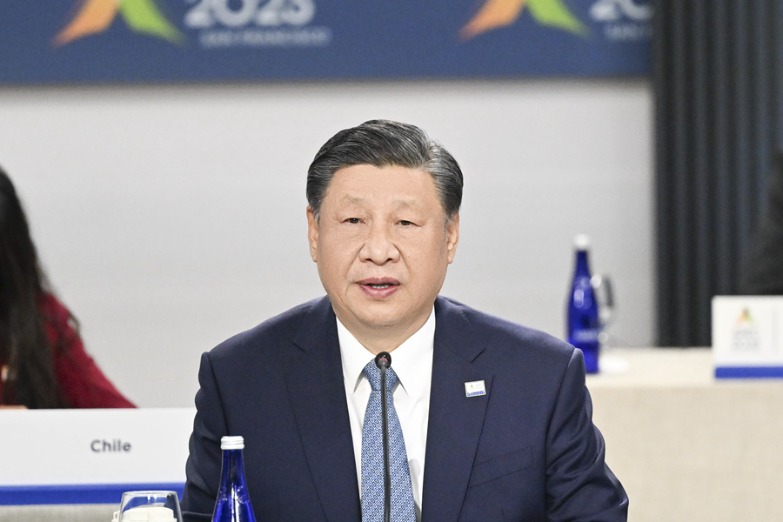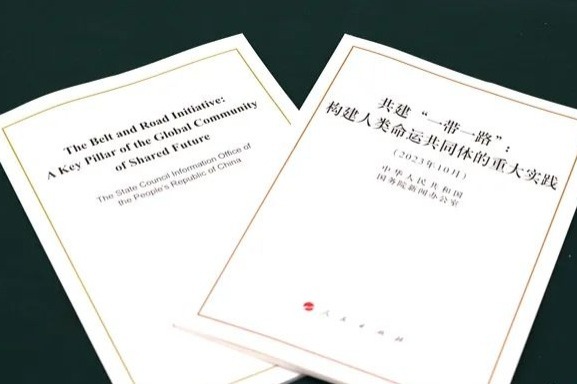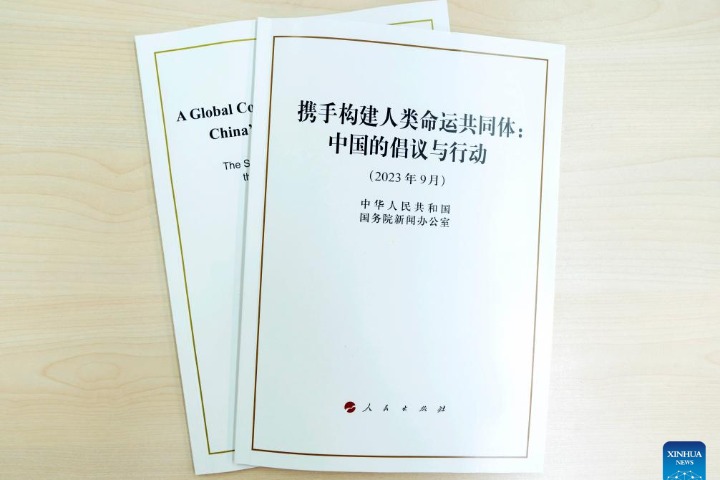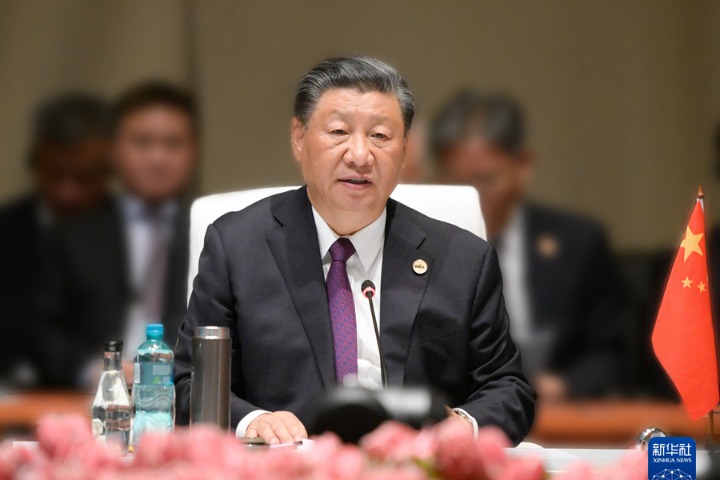西藏和平解放与繁荣发展(双语全文)
新华网 2021-05-21 16:00

六、优秀传统文化得到保护和发展
VI. Protection and Development of Traditional Culture
国家高度重视保护和发展西藏传统文化,投入巨大人力、财力、物力,运用法律、经济和行政等多种手段,使西藏优秀传统文化在有效保护的基础上得到了弘扬和发展。
China attaches great importance to the protection and development of traditional Tibetan culture. It has invested huge human, financial and material resources to protect, develop and carry forward the fine traditional culture of Tibet through a variety of legal, economic and administrative means.
——藏语言文字得到广泛使用
– The Tibetan spoken and written language is widely used.
藏语文的学习、使用受到法律保护。自治区成立以来,西藏自治区人民代表大会通过的决议、法规,西藏各级政府和政府各部门下达的正式文件、发布的公告都使用汉藏两种文字。地方各级政府和企事业单位组织的大型会议和主要活动中,行文坚持使用汉藏两种文字。司法诉讼活动中,根据藏族诉讼参与人的需要使用藏语文审理案件、制作法律文书,保障藏族公民使用藏语言文字诉讼的权利。目前,西藏公开发行藏文期刊16种、藏文报纸12种,累计出版藏文图书7185种、4009万册。此外,藏语言文字在卫生、邮政、通讯、交通、金融、科技等领域都得到广泛使用。
The study and use of the Tibetan language is protected by law. Since the founding of the Tibet Autonomous Region, the resolutions and regulations adopted by its people's congress, and the official documents and announcements by governments at various levels and government departments have all been issued in Chinese and Tibetan. The two languages are used in large meetings and major activities organized by local governments, enterprises and public institutions. In judicial proceedings, the Tibetan language is used to hear cases and make legal documents in accordance with the needs of Tibetan litigants, so as to guarantee the right of Tibetan citizens to use the language for litigation. Tibet now has 16 periodicals and 12 newspapers in the Tibetan language, and has published more than 40 million copies of 7,185 Tibetan-language books. In addition, the language is widely used in health, postal services, communications, transport, finance, and science and technology.
藏文典籍得到保护和利用。1984年,国家拨款新建西藏自治区档案馆,保存和收藏了大量珍贵的藏文档案,目前馆藏档案达300多万卷(册、件)。持续支持重要藏文经典的搜集、整理、翻译和出版工作,组织对勘出版《中华大藏经》藏文版,抢救整理《格萨尔王传》,出版《先哲遗书》丛书、《中华大典·藏文卷》、“雪域文库”丛书等众多宝贵藏文典籍。
Tibetan classics are protected and utilized. In 1984, the state allocated funds for the establishment of the Archives of the Tibet Autonomous Region, which houses and preserves a large number of precious Tibetan archives. The archives in its collection now number more than 3 million items. The state supports the collection, collation, translation and publication of important Tibetan classics. It has organized the collation and publication of the Tibetan-language Chinese Tripitaka, the rescue and collation of the epic Life of King Gesar, and the publication of many valuable Tibetan classics, including the Collected Works of Ancient Tibetan Scholars, Library of Chinese Classics: Tibet Volume, and the “Library of Snowfield Classics” series.
高度重视藏语术语标准化工作。1995年,成立全国藏语术语标准化工作委员会,2018年,工作委员会发布《党的十八大以来审定的藏语新词术语》,包含近1500条藏语新词术语。藏语文信息化、藏文软件研发推广等工作取得显著成果。1997年7月藏文编码标准正式获得通过,成为国际标准《信息技术 通用多八位编码字符集》的重要组成部分,藏语言文字成为第一个具有国际标准、获得全球信息高速公路通行证的中国少数民族语言文字。2004年,西藏自治区人民政府与国家信息产业部签订《关于藏文软件开发和推广应用的合作协议》,研发出输入法、操作系统、办公软件、网页浏览器等一系列基础性藏文软件。2015年底,国家标准《信息技术 藏文词汇》正式发布,标志着我国第一个少数民族文字的信息技术词汇国家标准正式诞生。
The standardization of Tibetan terminology is high on the state agenda. In 1995, the National Working Committee for the Standardization of Tibetan Terminology was established. In 2018, the working committee issued the New Tibetan Terms Approved Since the 18th National Congress of the Communist Party of China, which contains nearly 1,500 new terms. Remarkable results have been achieved in employing the Tibetan language in IT and in the research, development and promotion of Tibetan-language software. In July 1997, the Tibetan coded character set was officially adopted, and became an important part of the Information Technology – Universal Multiple-Octet Coded Character Set. The Tibetan language thus became the first ethnic-minority language in China with an international standard and a pass to the global information superhighway. In 2004, the People's Government of the Tibet Autonomous Region and the Ministry of Information Industry signed the Cooperation Agreement on the Development, Promotion and Application of Tibetan-Language Software, on which base a core set of Tibetan-language software was developed, including input method, operating system, office software, and web browser. At the end of 2015, the national standard Information Technology – Vocabulary in Tibetan was officially released, which marked the birth of China's first national standard vocabulary for information technology in an ethnic-minority language.
——风俗习惯得到充分尊重
– Customs and habits are fully respected.
国家尊重和保障西藏各民族按照传统风俗习惯生活和进行社会活动的权利。各族群众在保持服饰、饮食、住房的传统方式和风格的同时,也吸收了不少新的现代文化习俗。藏历新年、拉萨雪顿节、那曲赛马节等一大批群众性文化传统节庆得到继承和创新。近年来,增设“西藏百万农奴解放纪念日”,以及日喀则珠峰文化节、山南雅砻文化节、林芝桃花节等各种文化旅游节,丰富了广大人民群众的精神生活,展示了新时代西藏人民的精神风貌。
The state respects and protects the rights of all ethnic groups in Tibet to live and conduct social activities in accordance with traditional customs and habits. While maintaining their traditional ways and styles of dress, diet and housing, people of all ethnic groups have also absorbed many new and modern cultural customs. The Tibetan New Year, the Shoton Festival in Lhasa, and the Horse Racing Festival in Nagqu are among a large number of cultural and traditional festivals that have been conserved and upgraded. In recent years, various cultural and tourism festivals, such as the Commemoration Day for the Liberation of One Million Serfs in Tibet, the Mount Qomolangma Culture and Art Festival in Xigaze, the Yarlung Cultural Festival in Shannan, and the Peach Blossom Festival in Nyingchi, have enriched the lives of Tibetan people and showcased their vitality in the new era.
——文化遗产得到有效保护传承
– Cultural heritage is effectively protected and passed on.
几十年来,西藏多次组织大规模、有系统的文化遗产普查、搜集、整理和研究工作。现已调查登记的各类文物点4277处,各级文物保护单位1985处,其中国家级文物保护单位70处。继1972年维修大昭寺之后,国家持续投入巨额资金对布达拉宫、罗布林卡、大昭寺等文物古迹进行维修保护,仅1989年至1995年,国家就投入2亿多元对布达拉宫进行维修及广场扩建。2018年底,启动了周期10年、投资3亿元的布达拉宫文物(古籍文献)保护利用项目。2006年至2020年,安排资金34亿多元,实施西藏博物馆改扩建工程等155处文物保护单位的维修工程。35个村落列入中国传统村落名录,中央财政支持6900万元,保护了农耕文明传承和文化遗产,改善了农牧民居住环境。
Over the past few decades, Tibet has organized large-scale and systematic surveys, and the collection, collation and research of cultural heritage. A total of 4,277 cultural relics sites of all kinds have been examined and registered. Tibet has 1,985 cultural relics sites under the protection of governments at different levels, of which 70 are under state protection. Since restorative work was done on the Jokhang Temple in 1972, the state has continued to invest huge funds in the maintenance and protection of the Potala Palace, Norbulingka, Jokhang Temple and other cultural relics and historic sites. From 1989 to 1995 alone, the state invested more than RMB200 million in the maintenance of the Potala Palace and the expansion of its square. At the end of 2018, the state launched a 10-year project to protect and utilize cultural relics of the Potala Palace – mainly ancient books and documents – at an investment of RMB300 million. From 2006 to 2020, the state allocated more than RMB3.4 billion for the maintenance of 155 cultural relic sites under protection, including the renovation and expansion of the Tibet Museum. Thirty-five villages have been added to the list of Traditional Chinese Villages, and central government funding of RMB69 million has been used to protect elements of agricultural civilization and cultural heritage and to improve the living environment of farmers and herdsmen.
国家重视支持藏医药的传承发展。建立西藏藏医药大学,培养了7000余名藏医药专业人才。规范藏医诊疗标准,目前西藏公立藏医医疗机构达44所,乡镇卫生院和村卫生室藏医药服务覆盖率分别达到94.4%和42.4%。藏药生产迈向标准化、规范化、规模化的工业化生产,藏医药产业体系基本形成。西藏已有17家藏药生产企业通过国家GMP认证,拥有311个藏药国药准字号。启动民族医药古籍文献整理项目,截至2020年,已完成145部藏医药、天文历算的古籍整理与出版发行。国家已先后整理出版300多部藏医药古籍文献,收集珍贵古籍文本600多卷。
The state makes a point of supporting the inheritance and development of Tibetan medicine. It established the University of Tibetan Medicine, which has trained more than 7,000 professionals in this field. It has standardized the diagnosis and treatment of Tibetan medicine. There are 44 public Tibetan medical institutions in Tibet, and about 94 percent of township health centers and 42 percent of village health clinics provide Tibetan medicine services. Industrial production of Tibetan medicine has been scaled up and standardized, and a basic Tibetan medicine industry chain has taken shape. Seventeen Tibetan medicine manufacturers in Tibet have passed GMP certification, and 311 Tibetan drugs have been approved by the state. The state has launched a project to collate ancient books on ethnic medicine. By 2020, 145 ancient books on Tibetan medicine, astronomy and calendars had been collated, published and distributed. Over the years, the state has compiled and published more than 300 ancient books on Tibetan medicine, and collected more than 600 volumes of rare ancient books.
2006年以来,中央财政累计投入2.09亿元,用于西藏国家级非物质文化遗产代表性项目的保护、国家级代表性传承人的抢救性记录、非物质文化遗产传承人群培训以及扶持传承人开展传习活动、非物质文化遗产保护利用项目基地建设等。目前,西藏有联合国人类非物质文化遗产代表作3项(格萨〈斯〉尔、藏戏、藏医药浴法);国家级代表性项目89项,国家级代表性传承人96名,自治区级代表性项目460项,自治区级代表性传承人522名。
Since 2006, the state has invested a total of RMB209 million in Tibet in the following areas – protecting intangible cultural heritage (ICH) items on the national representative list, taking steps to record and conserve the knowledge and skills of the bearers of the ICH items on the national list, training ICH practitioners, and assisting them to set up sites for the protection and utilization of intangible cultural heritage and pass on their skills. Tibet now has three items (Gesar, Tibetan opera and Lum medicinal bathing of Sowa Rigpa) included on the UNESCO Intangible Cultural Heritage List. There are 89 items on the national ICH list with 96 state-level representative bearers, 460 items on the regional list with 522 regional-level representative bearers.
七、民族宗教工作成效显著
VII. Remarkable Results in Ethnic and Religious Work
国家制定一系列方针政策,全面落实民族区域自治制度,依法保护正常宗教活动,促进各民族共同团结奋斗、共同繁荣发展。
The state formulates guidelines and policies to fully implement the system of regional ethnic autonomy, protect normal religious activities in accordance with the law, and promote the unity and common prosperity of all ethnic groups.
——民族区域自治制度全面实施
– The system of regional ethnic autonomy has been fully implemented.
民族区域自治制度是国家一项基本政治制度。1965年,西藏自治区成立,选举产生自治区人民委员会,民族区域自治制度在西藏全面实施。1984年,国家颁布实施《中华人民共和国民族区域自治法》。经过几十年探索实践,西藏各民族人民构建起平等团结互助和谐的社会主义民族关系。
The system of regional ethnic autonomy is a basic political system of the state. In 1965, the Tibet Autonomous Region was founded and its People's Committee was elected. Since then, the system of regional ethnic autonomy has been fully implemented in Tibet. In 1984, the central government promulgated and implemented the Law on Regional Ethnic Autonomy of the People's Republic of China. After decades of experimentation and practical work, people of all ethnic groups in Tibet have built ethnic relationships characterized by equality, unity, mutual support and harmony.
西藏人民依法享有当家作主权利。自治区成立以来,先后出台152部地方性法规和规范性文件,为维护各族人民的各项权益提供了重要法治保障。西藏各族人民积极行使宪法和法律所赋予的选举权和被选举权,参加全国和自治区各级人大代表选举,参与管理国家和地方事务。1979年以来,先后进行多次自治区、地(市)、县、乡(镇)四级换届选举,选民参选率都在90%以上,有些地方参选率达到100%。2018年1月18日公布的西藏自治区第十一届人民代表大会439名代表中,藏族和其他少数民族代表共289人,占65.83%。中国人民政治协商会议西藏委员会历届委员中的绝大多数是藏族和其他少数民族人士。坚持各民族平等参与、共同管理原则,在人口较少民族聚居区设立民族乡保障人口较少民族的权益。目前在山南、林芝、昌都三市人口较少民族聚居区共设立9个民族乡,其中门巴民族乡5个、珞巴民族乡3个、纳西民族乡1个。
People in Tibet enjoy the right to be masters of the country and the region in accordance with the law. Since its founding, the autonomous region has issued 152 local regulations and normative documents, providing an important legal guarantee for the rights and interests of all ethnic groups. People in Tibet actively exercise the right to vote and stand for election as prescribed by the Constitution and laws; they participate in the election of deputies to people's congresses at the national and local levels, and in the administration of state and local affairs. Since 1979, elections have been held at the regional, prefectural (city), county and township (town) levels, with the voter participation rate above 90 percent, and in some places as high as 100 percent. Of the 439 deputies to the 11th People's Congress of the Tibet Autonomous Region announced on January 18, 2018, 289 – almost exactly two-thirds – are from the Tibetan and other ethnic minorities. Most of the current and previous members of the Tibetan Committee of the Chinese People's Political Consultative Conference are or were Tibetan and other ethnic minorities. The state supports equal participation and joint management by all ethnic groups, and sets up ethnic townships in areas where ethnic groups with small populations live in compact communities, to protect the rights and interests of these groups. At present, nine ethnic townships have been set up in Shannan, Nyingchi and Qamdo, of which five are Monba townships, three are Lhoba townships and one is a Naxi township.
国家历来重视少数民族干部和人才培养。和平解放后,特别是民主改革过程中,大批农奴和奴隶出身的积极分子迅速成长,成为优秀的民族干部。1981年,西藏专门设立培养教育民族干部的机构,1989年,成立干部教育工作领导小组,通过培训学习、基层锻炼、异地交流、岗位轮换等多种形式,培养了大批少数民族行政和专业技术干部。
The state pays great attention to the training of officials and personnel from minority ethnic groups. After the liberation of Tibet, especially during democratic reform, a large number of liberated serfs and slaves grew rapidly into outstanding officials. By setting up a special institution to train and educate ethnic minority officials in 1981, and a leading group for official education in 1989, Tibet has cultivated a large number of administrative and technical ethnic minority officials through training, job rotation, providing work opportunities at the grass-roots, and arranging for leading officials to hold posts in different localities.
——中华民族共同体意识更加牢固
– The sense of national identity has been heightened.
西藏自古以来就有各民族交往交流交融的优良传统。早在西藏和平解放之初,就有大批各族各界人士到其他省市参观考察。改革开放后,各民族间的经济、文化交流更加紧密,中华民族共同体意识更加牢固。每年在国庆节、西藏和平解放、“民族团结月”等节庆节点,大力开展中国梦主题教育、爱国主义教育,民族团结进步事业得到进一步发展。目前,国务院、西藏自治区表彰的民族团结进步先进单位共有1985个(次)、先进个人2846人(次),拉萨、日喀则、昌都、阿里先后成为全国民族团结进步示范市(地)。截至2020年,西藏颁布实施关于民族团结进步模范区创建条例等地方性法规1部、规范性文件4个。西藏籍学生和劳动者到其他省市就业创业,每年约有10%以上的西藏籍大学生选择区外就业。鼓励其他省市人员在藏求学投资兴业,不断创新招商引资举措,2016年以来出台涉及税收、金融、土地等52条特殊优惠政策,有效提高行政审批效率和服务质量,招商引资到位资金达2535亿元。积极打造各民族互嵌式社会结构和社区环境,大力促进公共服务均等化,保障城市和散居地区少数民族合法权益,尊重他们在节庆、饮食、丧葬等方面的风俗习惯。
Tibet has had a fine tradition of exchanges, communication, and integration among ethnic groups since ancient times. In the early 1950s, a large number of people from various ethnic groups and sectors in Tibet visited other parts of China. Since reform and opening up in 1978, economic and cultural exchanges between ethnic groups have become closer and the sense of national identity has grown stronger. Every year on National Day, and during the Peaceful Liberation Celebration and the Ethnic Unity Month, Tibet conducts themed education on the Chinese Dream and patriotism. Thanks to these efforts, ethnic unity and progress have been promoted. To date the State Council and the Tibet Autonomous Region have presented 1,985 awards to exemplary organizations and 2,846 awards to exemplary individuals for ethnic unity and progress. Lhasa, Xigaze, Qamdo and Ngari have each become demonstration cities (prefectures) for ethnic unity and progress. By the end of 2020, Tibet had promulgated and implemented one regulation – Regulations on the Establishment of Model Areas for Ethnic Unity and Progress – and four normative documents on ethnic unity and progress. Tibetan students and workers are free to find jobs and start businesses anywhere in the rest of China. Every year, more than 10 percent of Tibetan college students take jobs outside the autonomous region.
The autonomous region encourages people from other parts of China to study, invest and start businesses in Tibet, and constantly creates innovative new measures to attract investment. Since 2016, the region has issued 52 special preferential policies related to taxation, finance, and land, which have effectively improved the efficiency of administrative examination and approval and the quality of services. As a result, a total of RMB253.5 billion has been in place. The region has also worked hard to create an integrated social structure and community environment for all ethnic groups, promote equal access to public services, protect the legitimate rights and interests of ethnic minorities living in cities and scattered residential areas, and respect their festive, food and funeral customs and traditions.
——宗教信仰自由得到充分保障
– Freedom of religious belief is fully protected.
在西藏,各宗教、各教派一律平等,信教和不信教群众一视同仁。现有藏传佛教宗教活动场所1700多处,僧尼约4.6万人,清真寺4座,世居穆斯林群众12000余人,天主教堂1座,信徒700余人。为坚持我国宗教中国化方向,切实保障宗教信仰自由与秩序,依法管理宗教事务,依照《宗教事务条例》制定《藏传佛教活佛转世管理办法》,并制定《西藏自治区实施〈宗教事务条例〉办法(试行)》《西藏自治区大型宗教活动管理办法》《西藏自治区藏传佛教活佛转世管理办法实施细则》等一系列政策措施和规范性文件。
In Tibet, all religions and sects are equal, as are all believers and non-believers. There are more than 1,700 sites for Tibetan Buddhist activities with 46,000 monks and nuns, 4 mosques serving 12,000 native Muslims, and a Catholic church with more than 700 followers. In order to adapt religions to the Chinese context, ensure the freedom and order of religious belief, and manage religious affairs in accordance with the law, the state has formulated the Measures on the Management of the Reincarnation of Living Buddhas of Tibetan Buddhism in accordance with the Regulations on Religious Affairs. It has also formulated a series of policies, measures and regulatory documents, which include Measures of the Tibet Autonomous Region on Implementing the Regulations on Religious Affairs (trial), Measures of the Tibet Autonomous Region on the Management of Major Religious Activities, and Detailed Rules of the Tibet Autonomous Region for the Implementation of the Measures on the Management of Living Buddha Reincarnation of Tibetan Buddhism.
按照法规规章、宗教仪轨和历史定制,有序开展活佛转世认定。1995年,通过金瓶掣签,经国务院批准,完成十世班禅转世灵童寻访、认定以及十一世班禅坐床工作。2010年,经金瓶掣签,报西藏自治区人民政府批准,完成六世德珠活佛的认定和坐床工作。截至2020年,已有92位新转世活佛严格按照宗教仪轨和历史定制,得到批准和认定。依法开展正常宗教活动,寺庙学经、辩经、受戒、灌顶、修行等传统宗教活动和寺庙学经考核晋升学位活动正常进行。
The reincarnation of Living Buddhas has been carried out in an orderly manner in accordance with laws, regulations, religious rituals and historical conventions. In 1995, with the approval of the State Council, the search for and identification of the reincarnation of the 10th Panchen Lama and the enthronement of the 11th Panchen Lama were completed by drawing lots from a golden urn. In 2010, the Sixth Living Buddha Dezhub was identified and enthroned through the drawing of lots from a golden urn and with the approval of the government of the Tibet Autonomous Region. By 2020, 92 reincarnated Living Buddhas had been identified and approved through traditional religious rituals and historical conventions. Traditional religious activities are carried out regularly in accordance with the law – activities such as studying scriptures and debate, initiation as a monk or nun, abhisheka (an empowerment ceremony), and self-cultivation. Examination on scriptures and subsequent promotion in academic degrees are also held in monasteries on a regular basis.
西藏佛学院及其10所分院现有学经僧尼3000余人,2005年到2020年共有240人获得藏传佛教最高学衔“拓然巴”。寺庙传统印经院得到保留和发展,现有布达拉宫印经院等规模性传统印经院3家。信教群众正常参加萨噶达瓦节、拉萨祈愿大法会、马年转冈底斯山、羊年转纳木错等各种各样的宗教和传统活动。当前各级人民代表大会、政治协商会议中,有600余名宗教界人士担任代表、委员。
The Tibetan Buddhist Institute and its 10 branches now have more than 3,000 monks and nuns who are studying the sutras, and 240 received senior academic titles between 2005 and 2020. Monastery-run scripture printing houses have been conserved and developed; there are three large-scale printing houses at the Potala Palace and other monasteries. Religious believers regularly participate in various religious and traditional activities such as the Saga Dawa Festival, the Monlam Prayer Festival in Lhasa, the Tour of Gangdise Mountains in the Year of the Horse, and the Tour of Lake Namtso in the Year of the Sheep. Currently more than 600 religious figures serve as deputies or members of people's congresses and political consultative conferences at various levels.

















 英语点津微信
英语点津微信 双语小程序
双语小程序